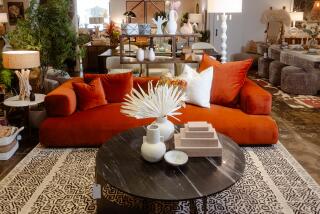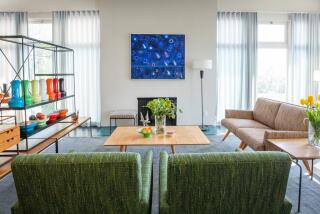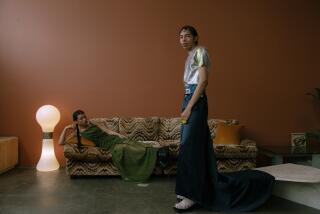FURNISHINGS : From the Mansions to the Museums
- Share via
Herter Brothers, a New York furniture and interior design firm, reigned supreme in the second half of the 19th Century.
Much of the furniture was made for mansions built with the wealth amassed by the captains of banking and industry such as Jay Gould, J. Pierpont Morgan and William H. Vanderbilt.
But times and tastes change. In 1870, Gustave Herter retired to his native Germany. His brother, Christian, died in 1883. And by 1906, the company that bore their name was out of business.
Then, in the 1940s and 1950s, as mansions turned into white elephants and were destroyed, their elaborate, large-scale furnishings were dispersed. Many wound up on Hollywood movie back lots as props in scores of movies, including “The Unsinkable Molly Brown,” the 1964 musical set in 1880s Denver.
Fast-forward to 1995. Herter Brothers’ work is enjoying a revival. Some 50 spectacular pieces are currently on display at the Metropolitan Museum of Art in New York.
Some of the most remarkable Herter pieces would overwhelm ordinary spaces. There is, for example, a 14-foot-high mirror console in rosewood with marquetry and gilding that introduces the exhibition. It took 19 workers 2 1/2 days to unpack and assemble the mirror that originally graced the music room of Thurlow Lodge. The mansion in Menlo Park, Calif., was built in the 1870s for Milton S. Latham, an investor and politician.
A scholarly catalogue, profusely illustrated, “Herter Brothers: Furniture and Interiors for a Gilded Age” (Abrams, $60 hardcover, $45 paper), has been published in conjunction with the exhibition, but it’s best to see the pieces firsthand.
Photographs don’t do justice to the rich materials, intricate design and fine workmanship. Whether it is carving, marquetry, inlay or upholstery, each piece is a revelation of a flamboyant, yet controlled, exuberance that could well be in a class of its own.
Herter furniture meets and often surpasses the best made in Europe; yet, it is uniquely American, according to curators.
William H. Vanderbilt’s New York City mansion, on Fifth Avenue near where Rockefeller Center now stands, is regarded as Christian Herter’s crowning achievement. It was begun in 1879 and took three years to build, with up to 700 men working 18 months to complete the elaborate woodworking and installation of the decor and furnishings.
Eight pieces of furniture from the Vanderbilt mansion are in the exhibition. They include a library table described in the catalogue as “immovable as granite and heavy as bronze” and a drawing room side chair of gilded maple and mother of pearl.
Even with a top-drawer clientele and distinctive style, a piece of Herter Brothers furniture, previously unknown, occasionally turns up. A velvet portiere, a heavy curtain usually hung in a doorway, which is in the exhibition was bought several years ago at a flea market by a New York textile collector. An elaborate dining room piece, recently discovered, is to be auctioned in California.
During its golden age from about 1858 to 1883, Herter Brothers made a lot of furniture, including pieces of normal scale. An authenticated grand piece such as the Thurlow Lodge mirror would probably fetch six figures today, and a standard-size chair might go for several thousand dollars, curators say.
A number of cabinetmaking firms worked in similar styles, and it may take an expert to make a secure attribution.


